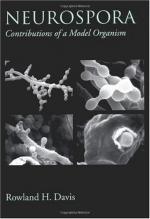|
This section contains 450 words (approx. 2 pages at 300 words per page) |

|
The bread mold Neurospora crassa is a simple fungal eukaryote which has been used extensively as a model organism to elucidate many of the principles of genetics of higher organisms. It is relatively easy to cultivate in the laboratory. Neurospora are eukaryotic organisms; that is, they organize their genes onto chromosomes. They may exist as either diploid cells (two copies of gene and chromosome) or haploid (one copy of each gene and chromosome). Neurospora has both a sexual and an asexual reproductive cycle which allows exploration of genetic processes more complex than those found in bacteria.
The asexual cycle consists of a filamentous growth of haploid mycelia. This stage is the vegetative stage. While the nuclei in this stage are indeed haploid, the tubular filaments contain multiple nuclei often without the distinction of individual cells. Under conditions of sparse food resources, the filaments (called hyphae) become segmented producing...
|
This section contains 450 words (approx. 2 pages at 300 words per page) |

|


